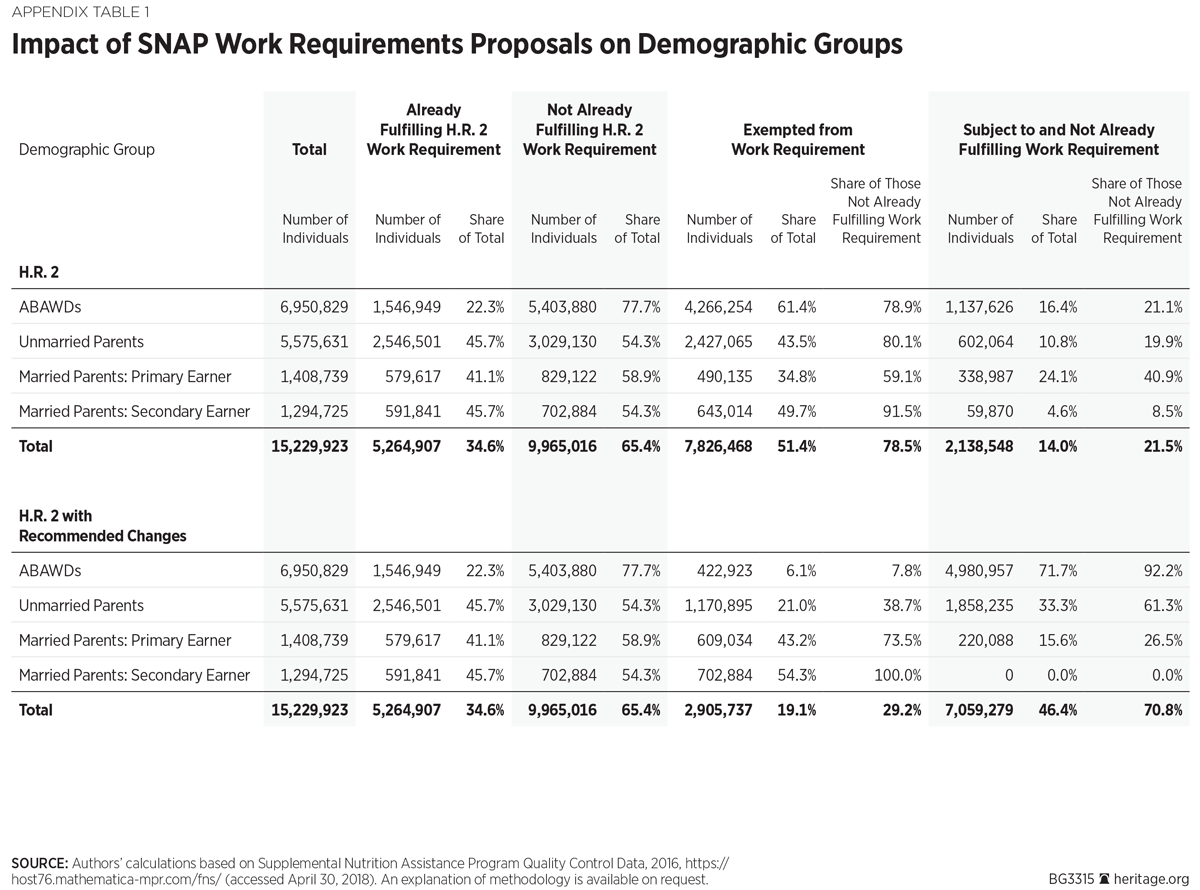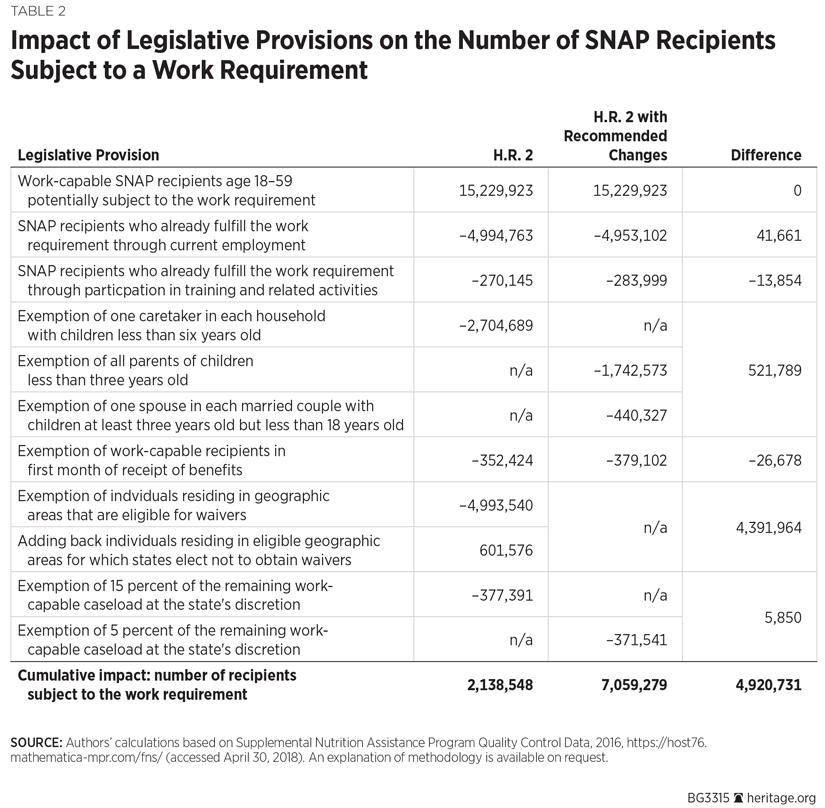On April 18, the House Committee on Agriculture approved H.R. 2, the Agriculture and Nutrition Act of 2018. The bill changes the food stamp program, also known as the Supplemental Nutrition Assistance Program (SNAP), with the intent of “making a historic commitment to helping recipients improve their outlook in life.”REF Committee Chairman Mike Conaway (R–TX) recently said that he hoped that under H.R. 2, “all nine and a half million” work-capable food stamp recipients without 20 hours of employment would be required to take a job, take training, or otherwise engage.REF
These are laudable goals, but H.R. 2 does not meet them and therefore requires significant changes. Two policies are needed to reduce poverty and improve well-being: requiring work and promoting stable marriage. This paper therefore examines two questions:
- How many work-capable food stamp recipients will actually be required to work or prepare for work under the provisions of the bill?
- How will the bill’s work provisions interact with the pervasive anti-marriage penalties already embedded in the food stamp program? Do the work requirements reduce the program’s strong underlying anti-marriage bias?
We find that of the 10 million work-capable food stamp recipients who are unemployed or work less than 20 hours per week, H.R. 2 would require only 2.1 million (or 20 percent) to work or prepare for work. H.R. 2 also perpetuates the anti-marriage bias of the food stamp program, which imposes substantial financial penalties on low-income parents who marry. This is problematic because marriage is a strong factor in reducing welfare dependence and child poverty and increasing well-being and upward mobility. If H.R. 2 were modified according to this paper’s recommendations, 7.05 million work-capable recipients (71 percent) would be required to work or prepare for work, and marriage financial penalties would be mitigated.
How Work Requirements Work
Some think that requiring work simply means insisting that welfare recipients find and hold private-sector jobs, but the process is more complex than that. When asked, many welfare recipients will state that they cannot currently find employment. When a work-capable recipient asserts that he cannot find a job, work programs require that individual to undertake “work activation” or “engagement activities” that include supervised job search, job preparation training, education, formal training, and workfare.
Mandatory engagement activities serve six functions. They (1) encourage recipients toward employment by removing the option of receiving free benefits while idle, (2) help recipients to locate employment, (3) provide training in the basic skills that are essential to holding a job, (4) provide formal education and training, (5) establish a quid pro quo by allowing recipients to provide service to the community in exchange for aid received; and (6) reduce fraud.
Each type of mandatory engagement activity encourages recipients toward employment because taking a job will generally be a better option than performing the required activities. Supervised job searches help recipients to find work. Job preparation programs include training in resume preparation, interview skills, and the fundamental skills needed to hold a job such as helping recipients to prepare for work by insisting that they show up at the program regularly and on time. Education and training provide vocation-related skills. Workfare programs allow recipients to “earn” their benefits by performing useful service to the community.REF
Engagement activities reduce fraud because many welfare recipients hold “off-the-books” jobs that are not reported to the welfare office. This allows them to double dip, receiving benefits for which they are not eligible while earning income from the hidden job. Mandatory engagement activities interfere with the recipient’s off-the-books employment and generally cause the individual to drop off the rolls. Other recipients have off-the-books household members with formal or informal income that is not reported to the welfare office because the office does not know the individual is present in the household. Off-the-books household members similarly allow the recipient to double dip, receiving benefits for which they are not eligible while sharing the unreported income. Because they have unreported sources of income, recipients in this situation will often have a lower need for benefits and will drop off the rolls rather than perform engagement activities.
Because of these factors, mandatory engagement generally results in substantial and rapid drops in welfare caseloads. For example, work requirements established in Maine in December 2014 for able-bodied adults without dependents (ABAWDs) receiving food stamps caused the enrollment in that group to drop by 80 percent in a few months.REF
Provisions of H.R. 2
H.R. 2 establishes work and engagement requirements for some food stamp recipients. The key provisions of the bill are as follows.
- Under current law, able-bodied adults without dependents between the ages of 18 and 49 are subject to a work/engagement requirement. H.R. 2 expands the requirement to cover ABAWDs aged 18 to 59.
- Able-bodied parents between the ages of 18 and 59 in families with children are subject to a work requirement for the first time.
- Recipients are exempt from that requirement during their first month after enrollment in food stamps; current law provides a three-month exemption.
- Individuals are considered to fulfill the work/engagement requirement if they currently have an average of at least 20 hours per week of employment; this is similar to current law.
- Recipients who are caregivers of children under age six in their household are exempt from the work/engagement requirement.
- In a married-couple family with children, both spouses are subject to a separate work requirement; the employment or work activity of one spouse cannot be used to offset the separate obligation on the other parent.
- The bill provides geographic area waivers from the work/engagement requirement that are very similar to current law. Recipients who reside in areas with 10 percent or higher unemployment rates or in areas with unemployment rates that are 20 percent higher than the national average (but not less than 6 percent) can be exempted from the work/engagement requirements upon state request.
- States, at their discretion, may exempt from a work/engagement requirement up to 15 percent of the recipients who would otherwise be subject to that requirement.
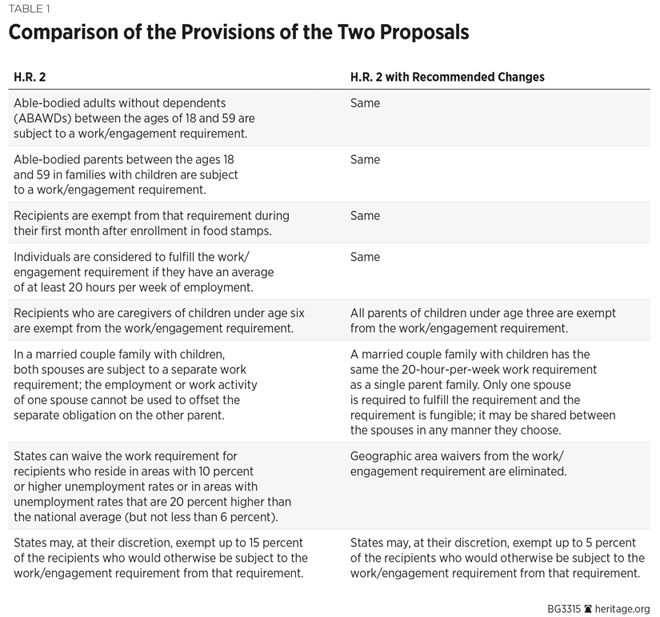
Recommended Changes
This paper also estimates the effects of an alternative approach that makes four key changes in H.R. 2’s food stamp policy:REF
- ABAWDs between the ages of 19 and 59 are subject to a work/engagement requirement. (Same as H.R. 2.)
- Able-bodied parents between the ages of 18 and 59 in families with children are subject to a work requirement. (Same as H.R. 2.)
- Recipients are exempt from that requirement during their first month after enrollment in food stamps. (Same as H.R. 2.)
- Individuals are considered to fulfill the work/engagement requirement if they currently have an average of at least 20 hours per week of employment. (Same as H.R. 2.)
- All parents in families with children under age three are exempt from the work/engagement requirement.
- The work requirement for married-couple families with children is the same as the 20-hour-per-week work requirement for a single-parent family. Only one spouse is required to fulfill the requirement, and the requirement is fungible; it may by shared between the spouses in any manner they choose.
- Geographic area exemptions from the work/engagement requirement are eliminated.
- States, at their discretion, may exempt from the work/engagement requirement up to 5 percent of the recipients who would otherwise be subject to that requirement. (The exemption in H.R. 2 is 15 percent.)
The overlapping and contrasting provisions of H.R. 2 and the alternative approach are shown in Table 1.
Four Key Changes in H.R. 2
There is considerable overlap between H.R. 2 and the alternative approach, and there are four key differences. The alternative plan (1) replaces the exemption for caretakers of children under six with an exemption for all parents in families with children under three; (2) establishes the same 20 hour per week work requirement for married-parent and single-parent families with older children, allowing the married parents to share the single obligation; (3) eliminates all geographic area waivers; and (4) allows states to exempt 5 percent rather than 15 percent of recipients otherwise subject to the requirement.
Impact of H.R. 2 vs. Impact of H.R. 2 with Four Key Changes
Table 2 compares the impact of H.R. 2 and the alternative approach on work. The figures represent food stamp recipients in a typical month. The analysis uses data from U.S. Department of Agriculture (USDA) Supplemental Nutrition Assistance Quality Control Data for 2016.
The top line of the chart shows that in the average month in 2016, 15.4 million able-bodied adults between the ages of 19 and 59 were receiving food stamp benefits. This population could be called the work-capable population; it includes both ABAWDs and parents and excludes disabled persons. The subsequent rows show the number of work-capable recipients who are excluded or exempted from the work/engagement obligation by the various provisions of the two plans. This process results in the figures in the bottom row (line 12), which are estimates of the total number of recipients who would actually be required to engage in additional work or engagement activities under each plan.
Complexity is added by the fact that many individuals would have multiple overlapping exemptions. In the table, each recipient is exempted only once. Precedence is given to the provisions higher on the table; if an individual is exempted on line 2, he is not counted as exempted a second time on line 8 even though he would be eligible for that exemption as well. As a consequence, identical provisions in the two plans may exempt slightly different numbers of recipients because the populations affected by the provision at that line will differ.
Line 2 on the table shows that 4.9 million work-capable individuals currently have at least 20 hours per week of employment and are therefore excluded from the work requirement. For purposes of the calculation on line 2, the employment of each spouse in a married-couple family is measured separately; a spouse is excluded only if he or she personally has at least 20 hours per week of employment. The employment of the other spouse is irrelevant. The slight difference between the two plans on this row is due to minor differences in how earnings can be counted toward employment.REF
Line 3 shows that roughly 270,000 are currently engaged in training and related activities that are sufficient to fulfill the work requirement.
Line 4 shows that the provision in H.R. 2 exempting direct caregivers of children under six would remove 2.7 million recipients from the work requirement population. The alternative plan does not have this provision. By contrast, the alternative plan would exempt both parents in a family with children under three; this provision, shown on line 5, would affect 1.7 million recipients.
In married-couple families with children between the ages of three and 18, the alternative plan would require only one parent to fulfill the 20-hour-per-week employment/engagement requirement. Spouses would be permitted to share this single obligation between themselves. Line 6 shows that this marriage-friendly provision would exempt around 440,000 individuals.
Both plans exempt recipients during the first month after enrollment. Line 7 shows that this affects 350,000 to 380,000 recipients.
Line 9 covers geographic area waivers. As explained below, H.R. 2 continues the current law with respect to geographic area waivers. As a result, in a typical year under H.R. 2, some five million work-capable people would reside in areas that could be covered by a geographic area waiver.REF This figure includes 3.2 million ABAWDs under age 50 who are currently exempt due to geographic area waivers. By contrast, the alternative plan eliminates geographic area waivers, greatly expanding the population covered by work requirements.
However, not all five million work-capable recipients residing in areas eligible for geographic area waivers would actually be exempted from the work requirement. This is because geographic area waivers are not applied automatically. A state government must submit a waiver requesting that the work requirement be suspended in a specified area. If the specified area is qualified for a geographic area waiver, the USDA will automatically approve the request.
Not all state governments request geographic area waivers. Currently, 17 states have no geographic area waivers.REF Some of these states may have no currently exemptible areas; others are states where the government has rejected geographic area waivers on policy grounds. In these 17 states, work-capable ABAWDs aged 50 to 59 and parents aged 19 to 59 would also not be affected by geographic waivers.REF The number of such individuals is estimated at 600,000. This figure is added back to the totals on line 9.REF
H.R. 2 allows states to exempt up to 15 percent of the remaining population subject to work requirements (after incorporating the preceding exemptions) from the work/engagement requirement. Line 10 shows that this reduces the number of recipients subject to the requirement by around 380,000. The alternative policy allows states to exempt up to 5 percent of the remaining population subject to work requirements (after incorporating the preceding exemptions) from the work/engagement requirement. As line 11 shows, this reduces the number of recipients subject to the requirement by around 370,000.REF
Line 12 shows the total number of work-capable recipients who would be subject to a work/engagement requirement after all potential exemptions were applied. Under H.R. 2, the figure is 2.13 million. Thus, out of a total of 15.3 million work-capable recipients, only 2.13 million (or 14 percent) would actually be required to work. By contrast, under the alternative plan, 7.05 million recipients (or 46 percent) would be subject to a work requirement. Chart 1 shows these numbers.
It is also important to consider the share of work-capable but non-employed recipients who would actually be required to work or prepare for work under the two plans. Under both plans, there would be about 10 million work-capable food stamp recipients with fewer than 20 hours per week of employment. H.R. 2 would impose a work requirement on about 21 percent of these recipients. The alternative plan would establish a work requirement on 71 percent of these recipients.

Examining Geographic Area Waivers
As Table 2 shows, geographic area waivers have a large impact on the number of food stamp recipients who are subject to work requirements. This should not be a surprise, as around two-thirds of the five million ABAWDs who received food stamps in 2016 were exempted from work requirements due to geographic area waivers. Typically, more than one-third of the U.S. population lives in areas eligible for these waivers.REF Food stamp recipients are even more heavily concentrated in these areas. In general, roughly half of work-capable food stamp recipients reside in areas that are eligible for geographic exemptions.REF In order to increase the number of food stamp recipients, especially ABAWDs, it is critical that the scope of geographic area waivers be reduced.
A main effect of the waivers from food stamp work requirements is that individuals living in areas with above-average unemployment are not asked to work or prepare for work in exchange for their benefits. This is unfair to the taxpayers and harmful to recipients. Work-capable recipients residing in areas with higher unemployment should not be put on the sidelines of society. Even if a recipient cannot find a job immediately, encouraging prolonged unemployment and idleness will not improve his situation. If recipients cannot find immediate employment, requiring them to participate in supervised job search, job preparation, training, or community service will make them readier for employment in the future. This can only help them to succeed in society in the long term; it is certainly far better than encouraging them to remain idle for long periods.
Criteria for Geographic Area Waivers
The current geographic area waiver provisions were created in the original welfare reform legislation that established the ABAWD work requirements in 1996. That law as codified in current federal regulations provides five basic types of geographic area waivers.REF At the request of a state government, the USDA will waive the work requirements in any area that:
- Had an average unemployment rate of more than 10 percent in the most recent 12-month period;
- Has a 24-month average unemployment rate that exceeds the national average by 20 percent for the same period;
- Is determined by the U.S. Department of Labor (DOL) Unemployment Insurance Service as qualifying for extended unemployment benefits;
- Is designated a basic labor surplus area by the DOL for the current fiscal year. (The DOL defines a basic labor surplus area as a jurisdiction with more than 10 percent unemployment or a jurisdiction with an unemployment rate that is more than 20 percent higher than the national average but not lower than 6 percent.REF); or
- Meets the DOL criteria for a labor surplus area due to “exceptional circumstances.”REF (This largely pertains to areas where unemployment is high as a result of natural disasters.)
Under the regulations, the term “area” is defined by the states.
H.R. 2 preserves these exemption criteria almost unchanged. Section 4015(a)(1)(F) defines the new criteria for a geographic area waiver as applying to any “area” that:
- Had an average unemployment rate of more than 10 percent in the most recent 12-month period;
- Has a 24-month average unemployment rate that exceeds the national average by 20 percent for the same period but is not less than 6 percent;
- Is determined by the DOL Unemployment Insurance Service as qualifying for extended unemployment benefits;
- Meets the DOL criteria for a labor surplus area due to “exceptional circumstances.” (This largely pertains to areas where unemployment is high as a result of natural disasters.)
The bill leaves the key term “area” undefined.
The bill removes the DOL basic labor surplus area criterion, but that criterion is virtually identical to the first two waiver provisions of H.R. 2 as outlined above. The omission of a basic labor surplus area definition does not appear to be significant.REF
Overall, H.R. 2 ratifies the status quo with respect to geographic area waivers, leaving the main criteria for granting geographic waivers from current law and regulation intact.REF The bill does make two marginal changes. First, it specifies that an area that has a 24-month average unemployment rate 20 percent or more above the national average can be waived only if the area’s 24-month average unemployment rate is less than 6 percent. Second, it seeks to limit the ability of states seeking geographic area waivers to combine areas within a state and average the unemployment rates within the combined area. The impact of these two modest changes is discussed below.
The 6 Percent Unemployment Floor
One minor way in which H.R. 2 limits geographic area waivers from the food stamp work requirement is by setting a floor of 6 percent on the unemployment rate that an area must have in order to qualify based on an unemployment rate at least 20 percent above the national average.
This new restriction matters only in the best of economic times. The floor will take effect only when the two-year average national unemployment rate is below 5 percent,REF which has occurred in only seven of the 41 years since 1971. Even when this rate is active, only a handful of localities would be affected.REF In other words, the floor hardly matters.
Combining Areas to Qualify for Geographic Area Waivers
The bill seeks to limit the ability of state governments to combine areas within a state and thereby obtain a work waiver on the basis of the average unemployment rate in the combined area. The bill states that the USDA may waive the entire state or “individual areas” within the state but cannot combine “areas.”REF
However, the term “individual areas” is not defined in the legislation. State governments can define “areas” as they choose. There is nothing in the bill, for example, to prevent a state from choosing to define seven contiguous counties as an “area.” In effect, the rule against combining “individual areas” is meaningless. Moreover, even if the term “individual areas” were defined precisely, it is unlikely that the anti-combining provision would significantly reduce the number of recipients covered by geographical waivers. This is because most current combined areas are rural areas with small populations. Only a small fraction of food stamp recipients appears to reside in these combined areas.REF
In addition, the tactic of un-combining counties or areas is limited by simple arithmetic. Suppose a state combines counties with the intent of raising the average unemployment rate in the combined area above a specified threshold of, say, 6 percent. For this to work, more than half of the recipients in the newly combined area would need to reside in counties with employment rates already above the 6 percent threshold. Separating the combined area would still leave at least half of the affected recipients in the combined area counties subject to a waiver.
Some might argue that the anti-combining rule would cut the number of recipients covered by geographic waivers in half. This could be true only if all current recipients resided in designated combined areas. This is clearly not the case. Some might also argue that the bill’s anti-combining provision will dramatically shrink the number of food stamp recipients covered by geographic waivers in the average year. So far, no detailed data have been made public to support this claim.REF
Disaggregating Urban Areas to Obtain Waivers
Another aspect of geographic area waivers is potentially far more significant than combining areas: disaggregating urban areas. This tactic, to our knowledge, has been deployed only by the administration of Mayor Bill DeBlasio in New York City, which currently seeks waivers for smaller areas within boroughs. The city has applied for and received ABAWD work waivers for areas such as Manhattan “above West 110th Street and East 96th Street” and another in Queens “south of Hillside Avenue and north of Belt Parkway, between Van Wyck Expressway on the west and Francis Lewis Boulevard and Springfield Boulevard on the east.”REF
Nothing in current law or H.R. 2 prevents city governments from applying for and receiving work waivers for areas as small as a ward, zip code, or elementary school enrollment area. If other large urban areas begin to copy New York City’s tactic, the resulting number of recipients exempted by geographical waivers would be far higher than the number shown in Table 2. This large, impending issue is not addressed in H.R. 2.
Bottom Line on Geographic Area Waivers
The primary reason that H.R. 2 requires a low level of work is that certain geographic areas remain exempt from work. Overall, the bill leaves the basic criteria for granting geographic area waivers intact and makes only small marginal changes.
It is likely that if the bill were enacted in its current form, roughly half of non-employed, work-capable food stamp recipients would continue to reside in areas potentially eligible for geographical waivers. Some states would refuse geographic area waivers, but the number of exempted recipients would still be as high as 4.4 million. This result is shown on lines 8 and 9 of Table 2.
Targeting Work Requirements
As noted, the alternative plan with its four key changes would require many more recipients to work or undertake engagement activities than H.R. 2 would require. Out of a total of 9.99 million work-capable recipients who are not currently employed, H.R. 2 requires 2.1 million or 21 percent to work or prepare for work.REF Under the alternative policy, 7.1 million or 71 percent would do so.
The policy differences would affect not only the number of recipients required to work or engage in work activation, but also the types of recipients so required. Particularly affected are parents with children. This is shown in Table 3 and Chart 2.
H.R. 2 would result in more married families being required to work relative to work-capable ABAWDs and non-married parents. Under current law, married parents with children comprise only 15 percent of all work-capable recipients with less than 20 hours of current employment. Nonetheless, under the bill, the new work requirement falls disproportionately on married families with children; 40 percent of all married-couple families with children would be subject to a work requirement, compared to 20 percent of ABAWDs and 20 percent of non-married parents. By contrast, under the alternative plan, more than 90 percent of ABAWDs would be subject to a work requirement.
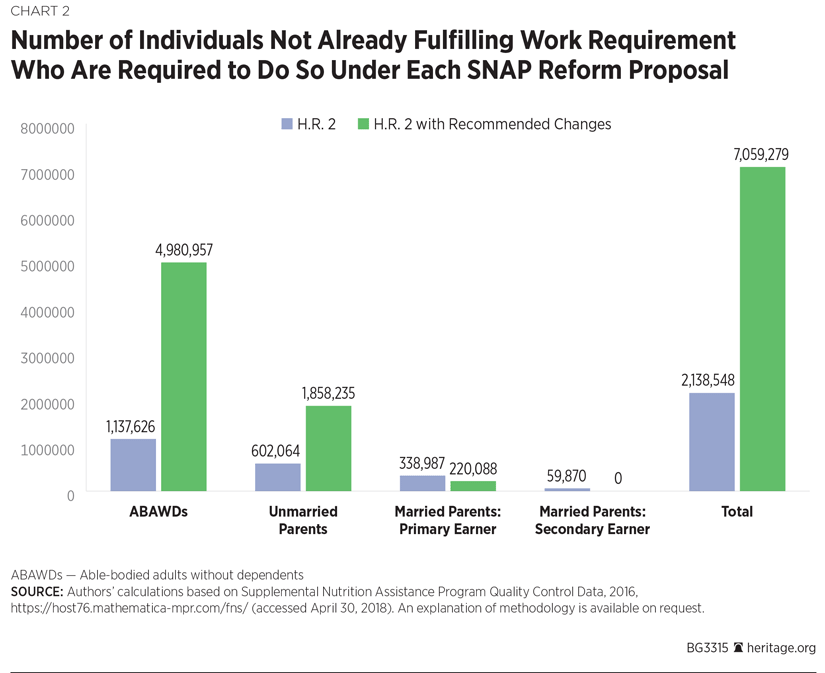
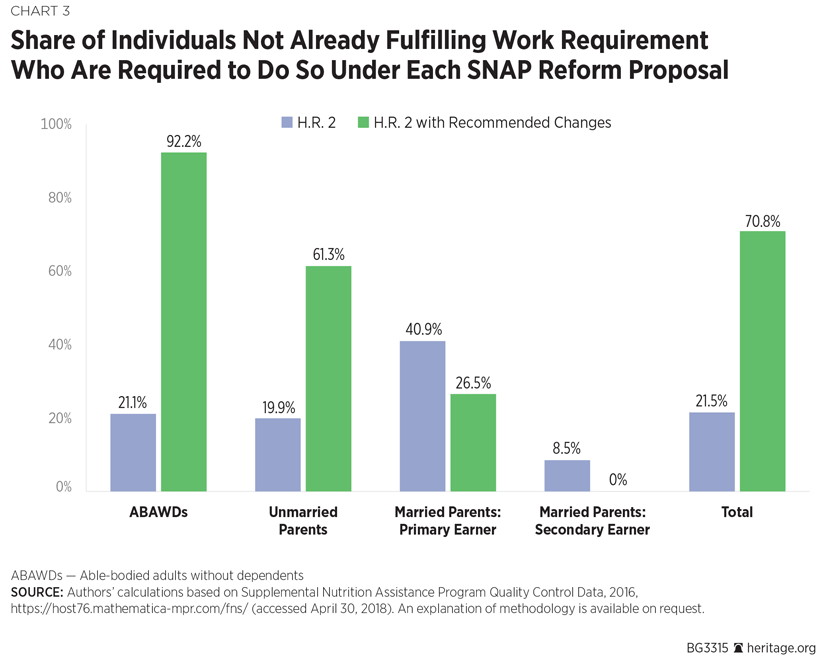
Importance of Marriage to Reducing Poverty and Dependence
Marriage is important to reducing poverty and dependence on the welfare state. This is demonstrated in part by the very small number of married families with children receiving food stamps compared to single parents and ABAWDs. Marriage dramatically reduces child poverty: Children born into homes without married parents are five times more likely to be in poverty, and adults who grew up in single-parent homes are 50 percent more likely to experience poverty than those who grew up in intact married homes. In addition, marriage is the single most important factor in promoting upward social mobility among children.
Marriage is also critical to improving life outcomes for adults and children. Married adults are twice as likely to report that they are happy as are unmarried adults. When compared to children in intact married homes, children raised by single parents are more likely to have emotional and behavioral problems; smoke, drink, and use drugs; be aggressive; engage in violent, delinquent, and criminal behavior; have poor school performance; be expelled; and drop out of high school. Children raised in single-parent homes are almost five times more likely to experience physical abuse and seven times more likely to suffer childhood sexual abuse when compared to those raised by married biological parents.
Children raised without a father in the home are three times more likely to engage in crime and end up in jail. Additionally, children who grow up in single-parent households are more likely to be arrested before age 30, become victims of sexual abuse, experience non-marital pregnancy and childbearing, and suffer from lower educational attainment. Finally, the importance of marriage in reducing dependence can be seen in the very small number of married families with children actually receiving food stamps compared to single parents and ABAWDs.
Unfortunately, marriage is in steady decline. When the War on Poverty began, only 7 percent of children were born outside of marriage. Today, the number is over 40 percent.
How Welfare and Food Stamps Penalize Marriage
The welfare system, including the food stamp program, imposes financial penalties on low-income couples who do marry. These programs penalize and discourage marriage because the benefits provided to a family are linked to the family’s aggregate earnings. As aggregate earnings increase, benefits decrease. In most cases, the presence of an employed father in the home greatly increases aggregate family earnings, leading to substantial decreases in or elimination of benefits. For example, marriage between parents can cause the couple to lose up to $5,000 per year in food stamp benefits alone.REF
H.R. 2 should be changed to address the critical importance of marriage in reducing child poverty and dependence and improving life outcomes. As drafted, the bill perpetuates the marriage penalties embedded in the current food stamp program. Some argue that the bill’s work provisions are neutral toward marriage;REF even if that were true, neutral provisions inside a program that already strongly discriminates against marriage do not constitute real neutrality. The bill assumes that requiring both spouses to work in a two-parent family is somehow more important than strengthening marriage itself. No evidence supports that idea.
By contrast, the suggested changes in H.R. 2 ensure that it would be marriage friendly. Only one parent in a married couple would be required to work. If a single mother marries the father of her children, the couple would still suffer a loss of benefits, but that loss would be partially offset by the fact that one spouse can shift his or her work obligation to the other. The work requirement mitigates the preexisting marriage penalty; this can encourage marriage, particularly when a single mother marries a father with reasonable earnings.
Conclusion
The public strongly supports welfare reform that requires work and strengthens marriage. Ninety four percent of Americans agree that “able-bodied adults who receive cash, food, housing, and medical assistance should be required to work or prepare for work as a condition of receiving those government benefits,” and 81 percent agree that “[t]he welfare system should not penalize parents when they get married”REF H.R. 2 does not meet this mark, but the changes outlined in this paper would ensure that it achieves both of these critical goals.
—Robert Rector is Senior Research Fellow and Jamie Bryan Hall is Senior Policy Analyst, Empirical Studies, in the Domestic Policy Studies Department, of the Institute for Family, Community, and Opportunity, at The Heritage Foundation.
